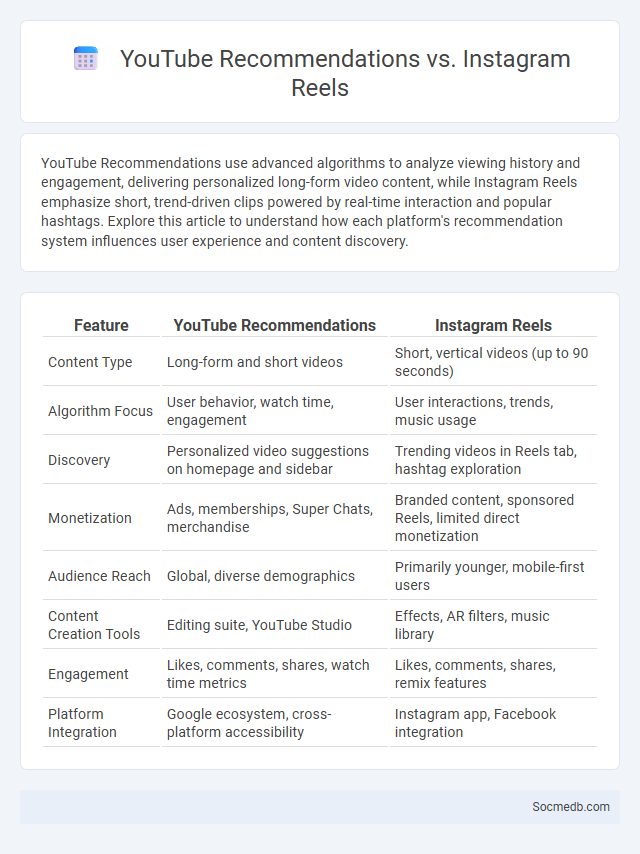
Photo illustration: YouTube Recommendations vs Instagram Reels
YouTube Recommendations use advanced algorithms to analyze viewing history and engagement, delivering personalized long-form video content, while Instagram Reels emphasize short, trend-driven clips powered by real-time interaction and popular hashtags. Explore this article to understand how each platform's recommendation system influences user experience and content discovery.
Table of Comparison
| Feature | YouTube Recommendations | Instagram Reels |
|---|---|---|
| Content Type | Long-form and short videos | Short, vertical videos (up to 90 seconds) |
| Algorithm Focus | User behavior, watch time, engagement | User interactions, trends, music usage |
| Discovery | Personalized video suggestions on homepage and sidebar | Trending videos in Reels tab, hashtag exploration |
| Monetization | Ads, memberships, Super Chats, merchandise | Branded content, sponsored Reels, limited direct monetization |
| Audience Reach | Global, diverse demographics | Primarily younger, mobile-first users |
| Content Creation Tools | Editing suite, YouTube Studio | Effects, AR filters, music library |
| Engagement | Likes, comments, shares, watch time metrics | Likes, comments, shares, remix features |
| Platform Integration | Google ecosystem, cross-platform accessibility | Instagram app, Facebook integration |
Introduction to Content Recommendation Algorithms
Content recommendation algorithms leverage user data, behavior patterns, and preferences to deliver personalized social media experiences. These algorithms analyze factors such as viewing history, engagement rates, and demographic information to suggest relevant posts, videos, or ads tailored to your interests. By optimizing content delivery, platforms enhance user engagement and increase time spent on social media.
How YouTube Recommendations Work
YouTube recommendations use a complex algorithm that analyzes your watch history, search queries, and user engagement to suggest videos tailored to your interests. The system employs machine learning models, such as deep neural networks, to predict which content you're likely to watch next based on patterns from billions of interactions. By continually refining its suggestions, YouTube aims to maximize watch time and keep You engaged on the platform.
Inside Instagram Reels Algorithm
Instagram Reels algorithm prioritizes content based on user engagement metrics such as likes, comments, shares, and watch time, which helps tailor personalized video feeds. The algorithm leverages machine learning to analyze user interactions, video information, and device/account settings, promoting content that aligns with individual preferences and trending topics. High-quality, relevant Reels that quickly capture attention and encourage interaction are more likely to be recommended across the platform, increasing visibility and reach.
Comparing User Engagement: YouTube vs Instagram
YouTube drives higher user engagement through longer video watch times averaging over 20 minutes per session, while Instagram focuses on shorter, visually-driven interactions such as Stories and Reels with average views of 1-2 minutes. Engagement rates on Instagram posts, especially within Stories, often surpass those on YouTube due to more frequent and diverse content consumption throughout the day. YouTube's algorithm promotes deeper content discovery and community building, whereas Instagram thrives on quick, high-volume interactions and trends.
Personalization Techniques in Video Platforms
Personalization techniques in video platforms leverage advanced algorithms to analyze your viewing history, preferences, and interactions, delivering customized content tailored to your interests. Machine learning models continuously refine recommendations by evaluating real-time engagement metrics and user behavior patterns. Enhanced personalization increases user retention and satisfaction by presenting relevant videos, optimizing your overall social media experience.
Strengths and Weaknesses of YouTube Recommendations
YouTube recommendations leverage advanced machine learning algorithms to analyze your viewing habits, providing highly personalized content that increases engagement and discovery of new videos. However, the system can create echo chambers by repeatedly suggesting similar content, limiting exposure to diverse perspectives and potentially promoting misinformation. Balancing YouTube's recommendation strengths with its weaknesses can help you optimize your content consumption while maintaining a broad and informed viewpoint.
Strengths and Weaknesses of Instagram Reels
Instagram Reels excels in user engagement by offering short, entertaining videos that leverage Instagram's large active user base, enhancing content discoverability through its algorithm-driven explore page. Its seamless integration with Instagram's ecosystem allows creators to easily share reels with followers and tap into trends, boosting viral potential. However, Reels faces challenges such as intense competition from platforms like TikTok, limited monetization options for new creators, and the risk of content oversaturation reducing visibility for individual posts.
Impact of Algorithms on Content Discovery
Algorithms on social media platforms significantly shape content discovery by prioritizing posts based on user behavior, engagement metrics, and relevance. This personalization increases user retention but can create echo chambers, limiting exposure to diverse perspectives. The evolving complexity of recommendation systems influences content visibility, often favoring sensational or trending topics to maximize interaction.
Monetization and Creator Support Differences
Social media platforms vary significantly in monetization strategies and creator support, with YouTube offering ad revenue sharing, channel memberships, and Super Chat features, whereas TikTok emphasizes creator funds and brand partnerships. Instagram focuses on sponsored content and shopping integrations, providing creators with direct product promotion opportunities, while Twitch prioritizes subscriptions and donations for live streamers. These differences influence how creators build sustainable income streams and engage audiences across platforms.
The Future of Content Recommendations on Social Media
The future of content recommendations on social media is driven by advancements in artificial intelligence and machine learning algorithms that analyze user behavior, preferences, and engagement patterns to deliver highly personalized and relevant content. Platforms like Facebook, Instagram, and TikTok continuously refine their recommendation systems to enhance user satisfaction and increase session duration by prioritizing content that aligns with individual interests. Emerging technologies such as natural language processing and computer vision further improve content curation by understanding context and multimedia elements, shaping a more intuitive and engaging user experience.
 socmedb.com
socmedb.com